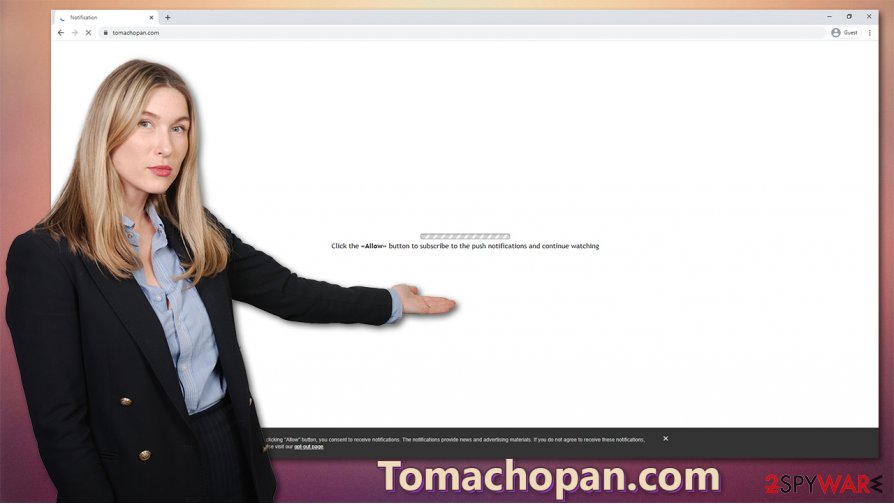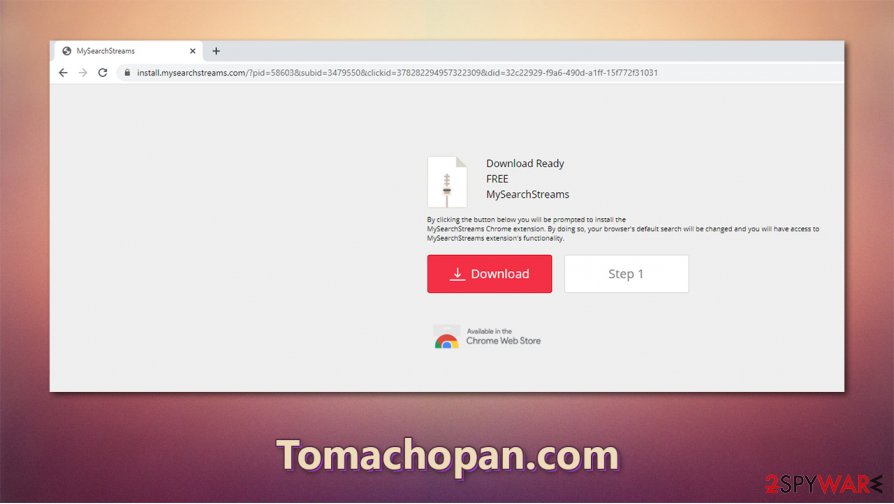Tomachopan.com (Removal Guide) - Chrome, Firefox, IE, Edge
Tomachopan.com Removal Guide
What is Tomachopan.com?
Tomachopan.com – a website that deceives people into subscribing to ads

Tomachopan.com is a website that people wouldn't visit on purpose. Usually, they are redirected to these types of sites. As soon as it's opened, it urges its visitors to click the Allow button, which would subscribe users to push notifications and allow them to continue watching some imaginary content. When the Allow button is pressed, this push notification virus will start displaying various ads, from banners to pop-ups, sometimes covering the device's whole screen.
Some ads might even be shown when the browser windows are closed, thus popping up directly on your desktop. Tomachopan.com redirects usually promote online gambling and other high-risk sites, which might lead to the installation of potentially unwanted programs (PUPs) or even worse. If you've allowed notifications or clicked on any of the ads, then we will help you resolve the annoying situation easily, as long as you follow guidelines provided in this article. We clarify the dangers of such ads and explain how to eliminate them from all types of devices and browsers.
| name | Tomachopan.com |
|---|---|
| Type | Adware, redirect, push notification virus |
| Symptoms | An excessive amount of ads appear out of nowhere, covering frequently visited sites. Some ads popping up when browsers are closed. Slower device performance. Redirects to questionable sites. |
| Risks | Deceptive ads and redirects might lead to PUPs installations, malware infections. |
| Distribution | Deceptive ads, software bundles, p2p services |
| Removal | This adware can be removed manually, but for peace of mind, anti-malware tools should be used to ensure no malicious content is present |
| System repair | To keep your device in good shape – system repair tools like the FortectIntego app should be used regularly |
Tomachopan.com ads might redirect to websites that have nothing to do with the advertised content. These deceptive ads show various content that tries to lure the unaware user into clicking them. The ads might include:
- online gaming,
- adult websites,
- online gambling,
- software download promotions,
- fake updates, etc.
Users can get their devices infected with various PUPs and malware. That's why it could be called Tomachopan.com virus. Additionally, it can be categorized as a potentially unwanted program[1] (PUP) because of its nature and posed dangers.
It's needless to say this website shouldn't be visited, and none of its displayed ads should be trusted and clicked on. If you're redirected to this page, then you might have adware installed on your device. We recommend performing a full system scan with SpyHunter 5Combo Cleaner or Malwarebytes or any other reliable anti-malware software to remove Tomachopan.com and any other suspicious entries, like adware, PUPs, or malware.
As great as anti-malware software is – it can't do everything. Users will have to intervene. Our cybersecurity team is sharing step-by-step Tomachopan.com removal instructions from the most popular browsers and devices. They are posted at the bottom of this article.

Adware and other PUPs can damage system files and settings, which might lead to abnormal system behavior. That's why experts[2] recommend using the FortectIntego system repair app or similar tools to fix any system irregularities and get the top performance from your device.
Dangers of push notifications viruses and how to identify them
Push notification viruses are delivered using social engineering tricks. These deceptive techniques urge people to subscribe to notifications in order to display an enormous amount of ads of affiliated third-party sites, which contents might be harmful.
Some websites might ask users to prove that they're not robots by doing a captcha test or similar techniques. In comparison, phony portals might ask to press the Allow button to do that, which immediately infect computers with adware. Other websites might ask to subscribe to their notifications to view some imaginary breaking news or hidden content.
Please remember that legitimate sites would never ask their visitors to allow their notifications in order to see some content. That's done only by websites with bad intentions such as installing adware, browser hijackers,[3] or other PUPs.
Remove Tomachopan.com virus from Chrome, Safari, and other browsers
If you see an abnormal amount of ads covering your frequently visited pages or some of them appear out of nowhere on your desktop, that means that your device is infected with Tomachopan.com virus. You came to the right place to find out how to eliminate it and get your device back in shape.
Manual Tomachopan.com removal is necessary to remove it from browsers themselves. Below you'll find step-by-step instructions on eliminating this adware from Safari, Firefox, and other browsers. Afterward, run a full system scan with anti-malware tools to remove any additional pieces, PUPs, or malware.

Once you remove Tomachopan.com, remember to use system repair tools to fix any system irregularities that the push notification virus might have caused. Unrepaired system files and settings could lead to freezing, crashing, BSoD, and other system issues.
Getting rid of Tomachopan.com. Follow these steps
Stop browser notifications
Tomachopan.com notifications popping up on your screen might not necessarily mean that your machine is infected. Therefore, you can try blocking the site's access to your computer first:
Remove unwanted notifications from Google Chrome (desktop):
- Open Google Chrome browser and go to Menu > Settings.
- Scroll down and click on Advanced.
- Locate Privacy and security section and pick Site Settings > Notifications.

- Look at the Allow section and look for a suspicious URL.
- Click the three vertical dots next to it and pick Block. This should remove unwanted notifications from Google Chrome.

Remove unwanted notifications from Google Chrome (Android):
- Open Google Chrome and tap on Settings (three vertical dots).
- Select Notifications.
- Scroll down to the Sites section.
- Locate the unwanted URL and toggle the button to the left (Off setting).

Remove unwanted notifications from Mozilla Firefox:
- Open Mozilla Firefox and go to Menu > Options.
- Click on Privacy & Security section.
- Under Permissions, you should be able to see Notifications. Click the Settings button next to it.

- In the Settings – Notification Permissions window, click on the drop-down menu by the URL in question.
- Select Block and then click on Save Changes. This should remove unwanted notifications from Mozilla Firefox.

Remove unwanted notifications from Safari:
- Click on Safari > Preferences…
- Go to the Websites tab and, under General, select Notifications.
- Select the web address in question, click the drop-down menu and select Deny.

Remove unwanted notifications from MS Edge:
- Open Microsoft Edge, and click the Settings and more button (three horizontal dots) at the top-right of the window.
- Select Settings and then go to Advanced.
- Under Website permissions, pick Manage permissions and select the URL in question.

- Toggle the switch to the left to turn notifications off on Microsoft Edge.

Remove unwanted notifications from MS Edge (Chromium):
- Open Microsoft Edge, and go to Settings.
- Select Site permissions.
- Go to Notifications on the right.
- Under Allow, you will find the unwanted entry.
- Click on More actions and select Block.

Remove unwanted notifications from Internet Explorer:
- Open Internet Explorer, and click on the Gear icon at the top-right of the window.
- Select Internet options and go to the Privacy tab.
- In the Pop-up Blocker section, click on Settings.
- Locate web address in question under Allowed sites and pick Remove.

Uninstall from Windows
If you have installed some suspicious programs on your computer, you can uninstall them easily as per the instructions below:
Instructions for Windows 10/8 machines:
- Enter Control Panel into Windows search box and hit Enter or click on the search result.
- Under Programs, select Uninstall a program.

- From the list, find the entry of the suspicious program.
- Right-click on the application and select Uninstall.
- If User Account Control shows up, click Yes.
- Wait till uninstallation process is complete and click OK.

If you are Windows 7/XP user, proceed with the following instructions:
- Click on Windows Start > Control Panel located on the right pane (if you are Windows XP user, click on Add/Remove Programs).
- In Control Panel, select Programs > Uninstall a program.

- Pick the unwanted application by clicking on it once.
- At the top, click Uninstall/Change.
- In the confirmation prompt, pick Yes.
- Click OK once the removal process is finished.
Delete from macOS
Remove items from Applications folder:
- From the menu bar, select Go > Applications.
- In the Applications folder, look for all related entries.
- Click on the app and drag it to Trash (or right-click and pick Move to Trash)

To fully remove an unwanted app, you need to access Application Support, LaunchAgents, and LaunchDaemons folders and delete relevant files:
- Select Go > Go to Folder.
- Enter /Library/Application Support and click Go or press Enter.
- In the Application Support folder, look for any dubious entries and then delete them.
- Now enter /Library/LaunchAgents and /Library/LaunchDaemons folders the same way and terminate all the related .plist files.

Remove from Microsoft Edge
Delete unwanted extensions from MS Edge:
- Select Menu (three horizontal dots at the top-right of the browser window) and pick Extensions.
- From the list, pick the extension and click on the Gear icon.
- Click on Uninstall at the bottom.

Clear cookies and other browser data:
- Click on the Menu (three horizontal dots at the top-right of the browser window) and select Privacy & security.
- Under Clear browsing data, pick Choose what to clear.
- Select everything (apart from passwords, although you might want to include Media licenses as well, if applicable) and click on Clear.

Restore new tab and homepage settings:
- Click the menu icon and choose Settings.
- Then find On startup section.
- Click Disable if you found any suspicious domain.
Reset MS Edge if the above steps did not work:
- Press on Ctrl + Shift + Esc to open Task Manager.
- Click on More details arrow at the bottom of the window.
- Select Details tab.
- Now scroll down and locate every entry with Microsoft Edge name in it. Right-click on each of them and select End Task to stop MS Edge from running.

If this solution failed to help you, you need to use an advanced Edge reset method. Note that you need to backup your data before proceeding.
- Find the following folder on your computer: C:\\Users\\%username%\\AppData\\Local\\Packages\\Microsoft.MicrosoftEdge_8wekyb3d8bbwe.
- Press Ctrl + A on your keyboard to select all folders.
- Right-click on them and pick Delete

- Now right-click on the Start button and pick Windows PowerShell (Admin).
- When the new window opens, copy and paste the following command, and then press Enter:
Get-AppXPackage -AllUsers -Name Microsoft.MicrosoftEdge | Foreach {Add-AppxPackage -DisableDevelopmentMode -Register “$($_.InstallLocation)\\AppXManifest.xml” -Verbose

Instructions for Chromium-based Edge
Delete extensions from MS Edge (Chromium):
- Open Edge and click select Settings > Extensions.
- Delete unwanted extensions by clicking Remove.

Clear cache and site data:
- Click on Menu and go to Settings.
- Select Privacy, search and services.
- Under Clear browsing data, pick Choose what to clear.
- Under Time range, pick All time.
- Select Clear now.

Reset Chromium-based MS Edge:
- Click on Menu and select Settings.
- On the left side, pick Reset settings.
- Select Restore settings to their default values.
- Confirm with Reset.

Remove from Mozilla Firefox (FF)
Remove dangerous extensions:
- Open Mozilla Firefox browser and click on the Menu (three horizontal lines at the top-right of the window).
- Select Add-ons.
- In here, select unwanted plugin and click Remove.

Reset the homepage:
- Click three horizontal lines at the top right corner to open the menu.
- Choose Options.
- Under Home options, enter your preferred site that will open every time you newly open the Mozilla Firefox.
Clear cookies and site data:
- Click Menu and pick Settings.
- Go to Privacy & Security section.
- Scroll down to locate Cookies and Site Data.
- Click on Clear Data…
- Select Cookies and Site Data, as well as Cached Web Content and press Clear.

Reset Mozilla Firefox
If clearing the browser as explained above did not help, reset Mozilla Firefox:
- Open Mozilla Firefox browser and click the Menu.
- Go to Help and then choose Troubleshooting Information.

- Under Give Firefox a tune up section, click on Refresh Firefox…
- Once the pop-up shows up, confirm the action by pressing on Refresh Firefox.

Remove from Google Chrome
You should clean Google Chrome appropriately to prevent further data tracking via the browser:
Delete malicious extensions from Google Chrome:
- Open Google Chrome, click on the Menu (three vertical dots at the top-right corner) and select More tools > Extensions.
- In the newly opened window, you will see all the installed extensions. Uninstall all the suspicious plugins that might be related to the unwanted program by clicking Remove.

Clear cache and web data from Chrome:
- Click on Menu and pick Settings.
- Under Privacy and security, select Clear browsing data.
- Select Browsing history, Cookies and other site data, as well as Cached images and files.
- Click Clear data.

Change your homepage:
- Click menu and choose Settings.
- Look for a suspicious site in the On startup section.
- Click on Open a specific or set of pages and click on three dots to find the Remove option.
Reset Google Chrome:
If the previous methods did not help you, reset Google Chrome to eliminate all the unwanted components:
- Click on Menu and select Settings.
- In the Settings, scroll down and click Advanced.
- Scroll down and locate Reset and clean up section.
- Now click Restore settings to their original defaults.
- Confirm with Reset settings.

Delete from Safari
Remove unwanted extensions from Safari:
- Click Safari > Preferences…
- In the new window, pick Extensions.
- Select the unwanted extension and select Uninstall.

Clear cookies and other website data from Safari:
- Click Safari > Clear History…
- From the drop-down menu under Clear, pick all history.
- Confirm with Clear History.

Reset Safari if the above-mentioned steps did not help you:
- Click Safari > Preferences…
- Go to Advanced tab.
- Tick the Show Develop menu in menu bar.
- From the menu bar, click Develop, and then select Empty Caches.

How to prevent from getting adware
Protect your privacy – employ a VPN
There are several ways how to make your online time more private – you can access an incognito tab. However, there is no secret that even in this mode, you are tracked for advertising purposes. There is a way to add an extra layer of protection and create a completely anonymous web browsing practice with the help of Private Internet Access VPN. This software reroutes traffic through different servers, thus leaving your IP address and geolocation in disguise. Besides, it is based on a strict no-log policy, meaning that no data will be recorded, leaked, and available for both first and third parties. The combination of a secure web browser and Private Internet Access VPN will let you browse the Internet without a feeling of being spied or targeted by criminals.
No backups? No problem. Use a data recovery tool
If you wonder how data loss can occur, you should not look any further for answers – human errors, malware attacks, hardware failures, power cuts, natural disasters, or even simple negligence. In some cases, lost files are extremely important, and many straight out panic when such an unfortunate course of events happen. Due to this, you should always ensure that you prepare proper data backups on a regular basis.
If you were caught by surprise and did not have any backups to restore your files from, not everything is lost. Data Recovery Pro is one of the leading file recovery solutions you can find on the market – it is likely to restore even lost emails or data located on an external device.
- ^ Potentially unwanted program. Wikipedia. The free encyclopedia.
- ^ Viruset. Viruset. Spyware news and security.
- ^ INFORMATION ON BROWSER HIJACKER. Bleepingcomputer. Technology news and support.

































